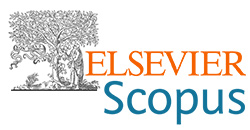Corrosion behavior of high- and low-chromium steel grinding balls in chloride solution
DOI:
https://doi.org/10.62638/zasmat998Abstract
The corrosion behaviour of three types of alloys (two low-alloy carbon steel and one stainless iron with ~15 wt.% Cr), in a solution which simulates seawater (3% NaCl solution, pH 8.1) was tested. Tested samples are used to make steel (iron) balls applied in mils for grinding copper and other ore. The corrosion tests were performed using three electrochemical methods, at room temperature in the presence of atmospheric oxygen. The linear polarization resistance (LPR) method, electrochemical impedance spectroscopy (EIS) method, and linear sweep voltammetry (LSV) method were applied. Based on measurements by LPR and EIS methods (as non-destructive methods), the value of polarization resistance (Rp) was determined and the general corrosion rate (vcorr) of the examined samples was calculated. The obtained values of the general corrosion rate can be used to calculate the service life of steel (iron) balls under exploitation conditions (seawater). The appearance of the surface after linear sweep voltammetry (LSV) measurement showed the presence of localized corrosion (pits were formed) of the tested samples, especially stainless iron, and the LSV method is not suitable for the determination of the general corrosion rate of tested samples in seawater. This form of corrosion occurs at high anodic polarizations, during performing LSV measurements.
Keywords:
Low-alloy Steel, Stainless Steel, Electrochemical Corrosion, LPR, EIS, LSV, SeawaterReferences
Standard Guide for Determining Synergism Between Wear and Corrosion: ASTM G119-2009. https://doi.org/10.1520/G0119-09.
E.McCafferty (2010) Introduction to Corrosion Science, Springer, New York
L.Yang (2021) Techniques for corrosion monitoring, Cambridge, England
R.Baboian (2005) ASTM Corrosion Tests and Standards: Application and Interpretation, second ed., ASTM International
Standard Guide for Conducting Corrosion Tests in Field Applications, ASTM G4-2014. https://doi.org/ 10.1520/G0004-01R14.
Standard Practice for Conducting Atmospheric Corrosion Tests on Metals, ASTM G50-2015. https://doi.org/10.1520/G0050-10R15.
K.Chiang, T.Mintz (2021) Gravimetric techniques, in Techniques for corrosion monitoring,Edited by L.Yang, Cambridge, England, p.239-254.
Standard Guide for Laboratory Immersion Corrosion Testing of Metals, ASTM G31-2012. https://doi.org/10.1520/G0031-12A.
Standard Practice for Exposure of Metals and Alloys by Alternate Immersion in Neutral 3.5 % Sodium Chloride Solution, ASTM G44-2013. https://doi.org/ 10.1520/G0044-99R13.
Corrosion tests in artificial atmospheres-Salt spray tests: ISO 9227-2017.
F.Mansfeld (1976) The Polarisation Resistance Technique for Measuring Corrosion Currents, in Advances in Corrosion Science and Technology, Vol. 6, Edited M.G.Fontana and R.W.Staehle, Plenum Press, New York and London, p.163-262.
J.R.Scully (2000) Polarization resistance methods for determination of instantaneous corrosion rates, Corrosion, 56(2), 199-218. https://doi.org/10. 5006/1.3280536
Standard Test Method for Conducting Potentiodynamic Polarization Resistance Measu-rements, ASTM G59-2014. https://doi.org/10. 1520/G0059-97R14.
R.G.Kelly, J.R.Scully, D.W.Shoesmith, R.G. Buchheit (2002) Electrochemical Techniques in Corrosion Science and Engineering, Marcell Dekker, New York
M.E.Orazem, B.Tribollet (2017) Electrochemical Impedance Spectroscopy, John Wiley &Sons, New Jersey
R.Srinivasan, F.Fasmin (2021) An Introduction to Electrochemical Impedance Spectroscopy, Taylor & Francis Group, New York
F.Mansfeld (2006) Electrochemical Impedance Spectroscopy, in Analytical Methods in Corrosion Science and Engineering, Edited By P. Marcus and F. Mansfeld, Taylor & Francis Group, p.463-505.
Standard Practice for Verification of Algorithm and Equipment for Electrochemical Impedance Measurements, ASTM G106-2015. https://doi.org/ 10.1520/G0106-89R15.
S. Papavinasam (2021) Electrochemical polarization techniques for corrosion monitoring, Techniques for corrosion monitoring, Edited by L.Yang, Cambridge, England, p.45-75.
E. Heitz (2006) DC Electrochemical Methods, in Analytical Methods, in Corrosion Sciencen and Engineering, Edited By P.Marcus and F.Mansfeld, Taylor & Francis Group, p.435-462.
F. Mansfeld (2003) Electrochemical methods of corrosion testing, in: ASM Handbook, Vol. 13A, Corrosion: Fundamentals, Testing and Protection, ASM International, p.446-462.
E.E.Stansbury, R.A. Buchanan (2000) Fundamentals of Electrochemical Corrosion, ASM International, Materials Park, Ohio
E. Bardal (2004) Corrosion and protection, Springer, London, Berlin, New York
Standard Test Method for Corrosion Potentials of Uncoated Reinforcing Steel in Concrete, ASTM-C876-2009. https://doi.org/10.1520/C0876-09.
Standard Guide for Development and Use of a Galvanic Series for Predicting Galvanic Corrosion Performance, ASTM G82-2014. https://doi.org/10. 1520/ G0082-98R14.
Standard Test Method for Measurement of Corrosion Potentials of Aluminum Alloys1ASTM G69-2012. https://doi.org/10.1520/G0069-12.
Test Method for Standard Test Method for Evaluating the Potential for Galvanic Corrosion for Medical Implants, ASTM F3044-2014. https://doi. org/ 10.1520/F3044-14.
Standard Guide for Electrode Potential Measurement, ASTM G215-2016.https://doi.org/ 10.1520/G0215-16.
B.V.Jegdić, B.M.Bobić, M.Bošnjakov (2017) Relationship between corrosion potential and different corrosion forms of metals, alloys and theirs welded joints - part I, Welding and Welded Structures, 62(2), 65-76. https://doi.org/10. 5937/zzk1702065J
B.V.Jegdić, B.M. Bobić, B.M. Radojković (2018) Relationship between corrosion potential and different corrosion forms of metals, alloys and theirs welded joints - part II, Welding and Welded Structures, 63(2), 53-63. https://doi.org/ 10.5937/zzk1802053J
M.Stern, A.L.Geary (1957) Electrochemical polarization. I. A theoretical analysis of the shape of the polarization curves, Journal of The Electro-chemical Society, 104(1), 56-63. https://doi.org/10. 1149/1.2428473
Standard Practice for Calculation of Corrosion Rates and Related Information from Electro-chemical Measurements, ASTM G102-2015.
B.Radojković, B.Jegdić, J.Pejić, D.Marunkić, A.Simović, S.Eraković-Pantović (2023) Influence of nitrogen content on the pit formation and pit propagation in the welded joints of X5CrNi18-10 stainless steel, Materiales Corrosion (accepted). https://doi.org/10.1002/maco.202314120







